Key takeaways:
- Butterfly conservation is vital for biodiversity and ecosystem health, as butterflies play a key role in pollination.
- Creating pesticide-free gardens enhances the health of pollinators and fosters a safer environment for children and pets.
- Choosing native plant species and maintaining diverse habitats contribute to attracting and supporting various butterfly species.
- Regular maintenance, including soil health, watering, and managing invasive species, is essential for a thriving pollinator garden.
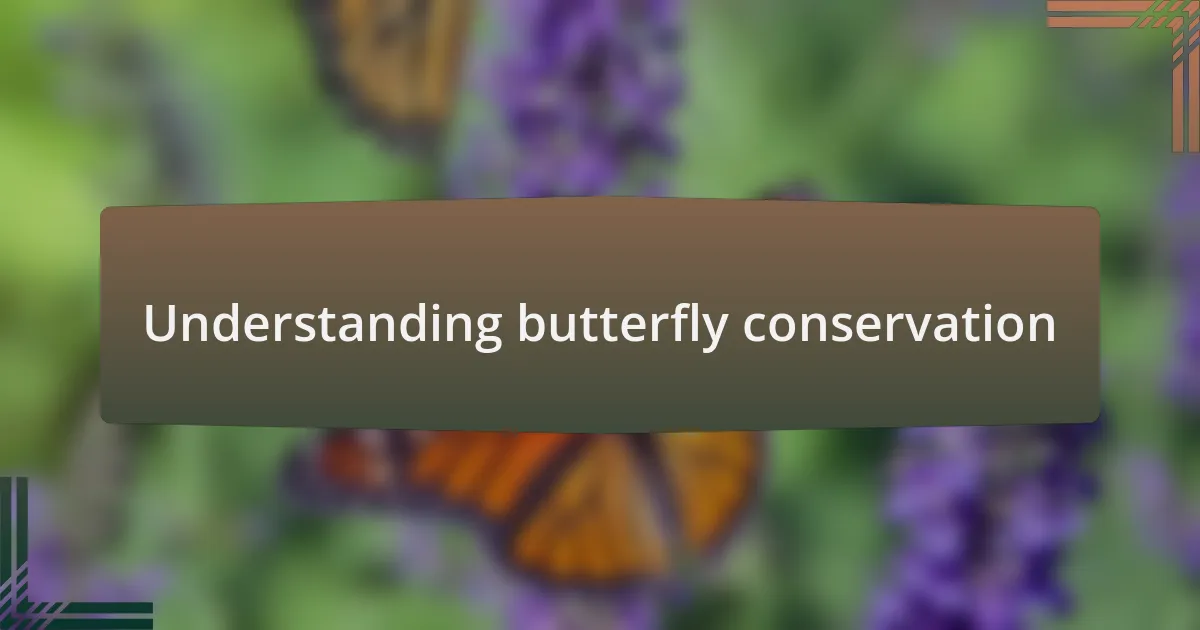
Understanding butterfly conservation
Butterfly conservation is crucial for maintaining biodiversity and ensuring healthy ecosystems. I remember the first time I spotted a Monarch resting on a milkweed plant; it felt magical, connecting me to nature in a way that was both profound and humbling. Why do these moments matter? Because every butterfly plays a role in pollination, and without them, our plant life—and ultimately, our food supply—could face serious consequences.
Understanding the threats butterflies face is equally essential. Habitat loss, climate change, and pesticide use can lead to declining populations, which is alarming when you consider their beauty and ecological importance. Reflecting on my experiences, I’ve noticed how a single butterfly sighting can uplift spirits and inspire conversations about nature’s fragility. Isn’t it our responsibility to protect these delicate creatures and their habitats?
Engaging in butterfly conservation also opens up opportunities for community involvement and education. I recall hosting a local butterfly garden workshop where participants shared their love for gardening and learning about pollinators. This sense of unity was invigorating, reminding me that collectively, we can create sanctuary spaces for butterflies and foster a deeper appreciation for the natural world. What could be more rewarding than knowing you’re nurturing life?
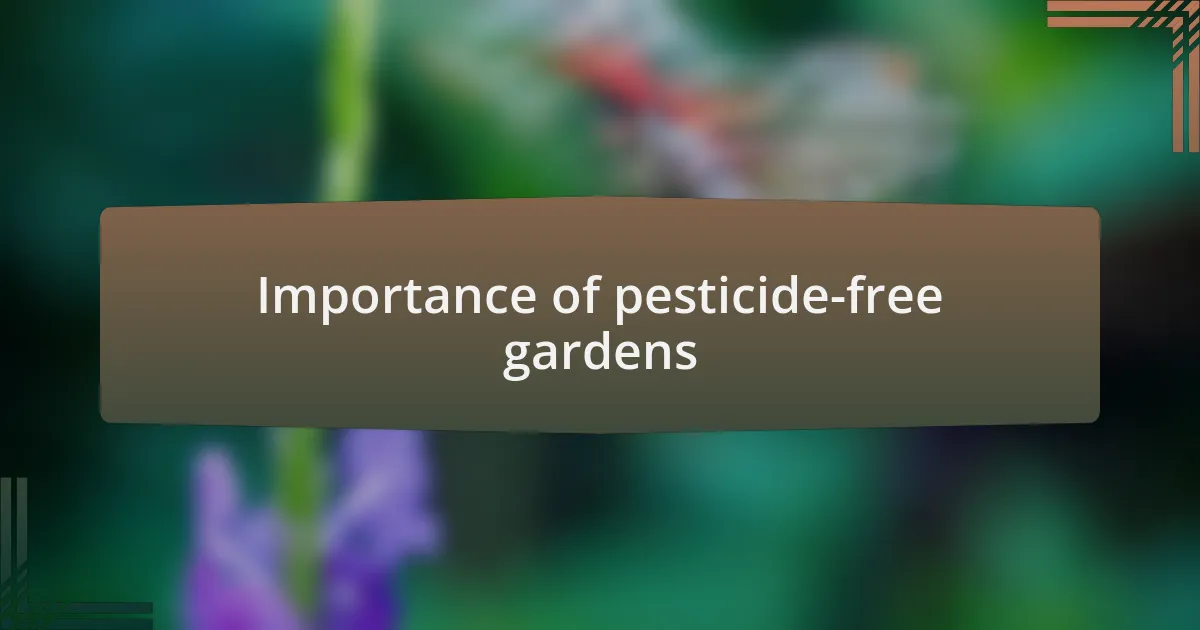
Importance of pesticide-free gardens
Creating pesticide-free gardens is essential for the health of our pollinators. I once visited a garden where the vibrant colors of butterflies and bees painted the landscape in a joyful dance. It struck me how alive everything felt—plants thrived, insects buzzed, and the ecosystem flourished. I couldn’t help but wonder how different it would have been if pesticides were introduced.
Pesticides can have devastating effects, not only on butterflies but also on beneficial insects that contribute to the overall health of our gardens. I remember speaking with a local gardener who transitioned to organic gardening; she mentioned how amazed she was at the transformation. The influx of butterflies and bees was a testament to the natural balance that a pesticide-free environment fosters. Isn’t it incredible how our choices can directly impact the lives of these delicate creatures?
Moreover, gardens free from pesticides offer a safer environment for children and pets. While watching my niece chase butterflies in our garden, I felt a profound sense of joy knowing she was experiencing nature without hidden dangers. It made me realize that creating these safe spaces contributes not only to ecological health but also nurtures our appreciation for the natural world. How often do we think about the legacy we leave for future generations?
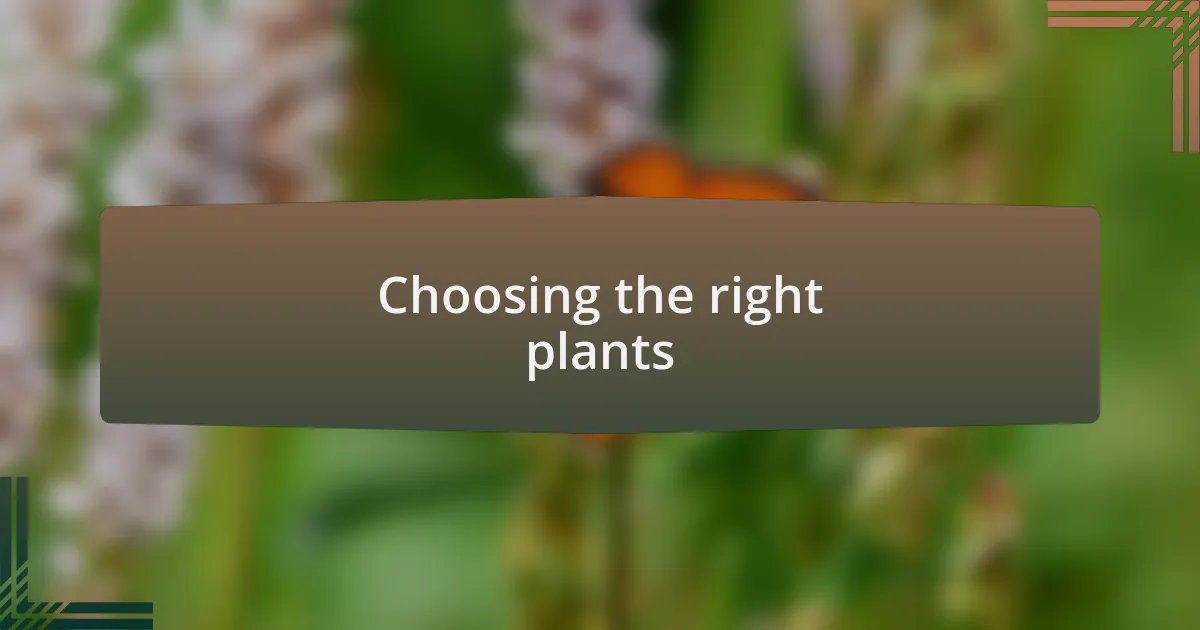
Choosing the right plants
When choosing the right plants for a pesticide-free pollinator garden, it’s essential to prioritize native species. I remember a time when I spontaneously visited a local nursery, drawn to a stunning display of native wildflowers. As I selected some plants for my garden, I felt a connection not just to their beauty but also to the local pollinators they would attract. Native plants are often better suited to the local environment, helping to create a thriving habitat where butterflies and other pollinators can flourish.
Additionally, I found that incorporating a variety of plant types and bloom times ensures that there’s a continuous food source for pollinators throughout the seasons. Once, I planted some early-blooming crocuses alongside late-summer asters, and I was delighted to see that my garden was a buzzing hub from spring’s first warmth all the way into autumn. Have you ever seen how different pollinators respond to different blooms? Watching them flit from flower to flower is a testament to the harmony that diverse plants can create.
Finally, it’s crucial to avoid hybrid varieties that may lack the nectar or pollen that pollinators need. I learned this the hard way when I noticed fewer butterflies visiting the fancy, hybrid blooms I had planted. It was an eye-opening moment that emphasized the value of selecting open-pollinated varieties, which not only attract a broader range of pollinators but also align with my goal of fostering a pesticide-free environment. When we rethink our plant choices, don’t we open the door to a more vibrant ecosystem?
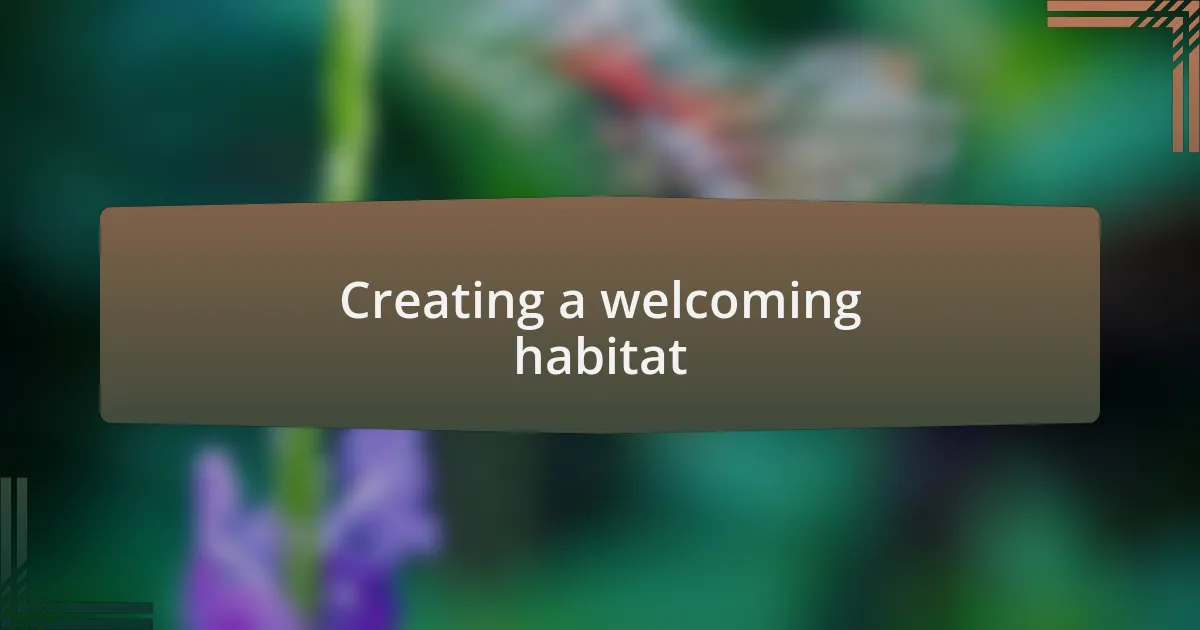
Creating a welcoming habitat
Creating diverse habitats is key to making butterflies and other pollinators feel at home in your garden. I remember transforming a bare patch of lawn into a blooming sanctuary by adding a mix of shrubs, flowers, and grasses. It was astonishing to see how quickly the area came to life; one warm afternoon, I sat quietly and watched as butterflies danced joyfully among the blooms. Don’t you love the feeling of witnessing nature come alive right before your eyes?
To further enhance the habitat, incorporating elements like water sources and shelter becomes vital. I once added a small, shallow dish filled with fresh water, topped with smooth stones for easy access. Almost immediately, I noticed butterflies stopping by for a sip on hot days. This simple addition not only nourished them but also created a serene oasis where I could sit and enjoy the calmness of nature. Have you considered how even a small change can significantly impact your garden’s ecosystem?
Finally, it’s important to remember that providing shelter is just as essential as food and water. I realized this when I installed a few bee hotels in my garden, observing bees quickly claiming them as their home. Watching them come and go, I felt a sense of satisfaction knowing I was contributing to their well-being. What if we all made space for nature’s little architects? By creating sheltered areas, you invite a host of beneficial insects, enriching the biodiversity of your space.

Attracting diverse butterfly species
To attract a variety of butterfly species, I found that planting a diverse array of nectar-rich flowers is essential. When I planted clusters of milkweed, coneflower, and lantana, I was delighted to see different butterflies visit, from Monarchs to Swallowtails. It’s fascinating how each species has its preferred flowers—did you know that some butterflies are drawn to specific colors or scents?
Another effective strategy I’ve discovered is planting in groups rather than scattering flowers throughout the garden. I remember grouping bright zinnias in a sunny spot, and within days, they became a hotspot for butterflies. The sheer sight of vibrant butterflies flitting from bloom to bloom brought me immense joy. Have you tried grouping plants to create inviting clusters for butterflies? This method seems to resonate with their natural behavior, encouraging more visits.
Lastly, don’t underestimate the importance of native plants. I started introducing local wildflowers into my garden, and the response was remarkable. Suddenly, my garden became a mini migration hub, with butterflies that I had never seen before stopping by. Each butterfly flitting through my garden reminded me of the interconnectedness of life; isn’t it thrilling to think that by simply planting the right species, I could help support the delicate balance of our ecosystem?
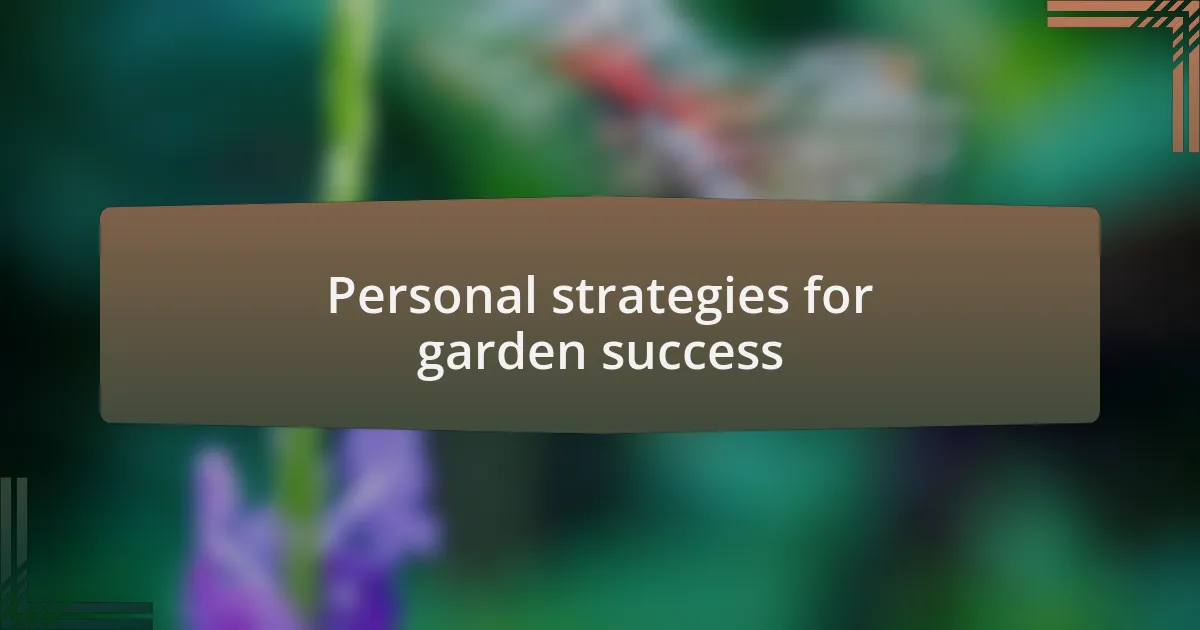
Personal strategies for garden success
Creating a pesticide-free environment is crucial for fostering a thriving pollinator garden. I remember the first time I realized just how impactful organic practices could be—I had been using homemade neem oil to combat pests, and it was rewarding to see the garden’s health improve while butterflies danced among the flowers. Have you ever tried making your own natural pest deterrents? It feels good to know I’m caring for the garden and its visitors in a way that’s safe and sustainable.
Another strategy I’ve adopted involves maintaining a diverse range of host plants for caterpillars. I was initially surprised to discover how many different butterflies rely on specific plants for their larvae. By planting options like parsley for Swallowtails and milkweed for Monarchs, I’ve seen an increase in caterpillar activity and, in turn, more adults emerging to add beauty to my garden. Isn’t it incredible to witness the full life cycle right in your backyard?
Lastly, I believe companion planting can work wonders. I’ve had great success pairing flowers with vegetables in strategic ways. One particularly memorable summer, I planted marigolds alongside tomatoes, which not only kept pests at bay but also attracted butterflies that were wonderfully unexpected. Have you considered how combining different plants can enhance your garden’s ecosystem? The symbiotic relationships created through these pairings contribute to both pollinator health and my garden’s overall productivity.
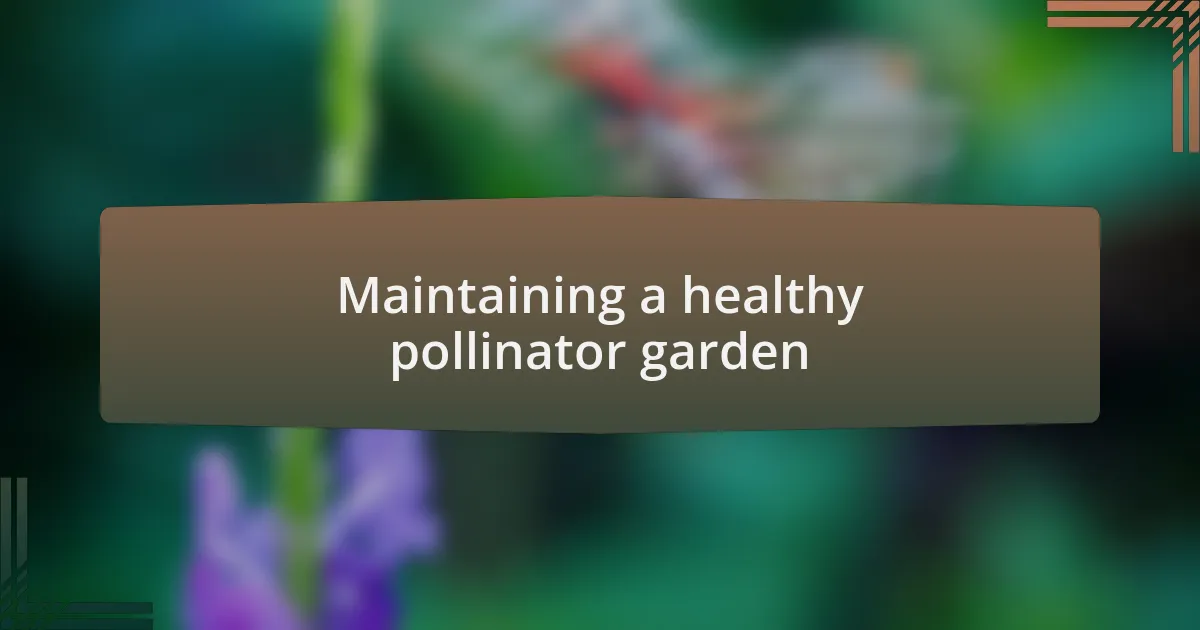
Maintaining a healthy pollinator garden
Maintaining a healthy pollinator garden requires regular attention to soil health. I’ll never forget the first time I tested my soil and discovered it was lacking in essential nutrients. After incorporating compost and organic matter, not only did the plants flourish, but I also noticed an influx of different pollinators visiting. Have you ever thought about how a little nurturing can make such a big difference?
Another essential aspect is watering. I’ve learned that consistent, deep watering is key during dry spells. During one particularly hot summer, I religiously watered my garden in the early mornings and watched as life thrived—bees buzzing and butterflies fluttering everywhere. It’s fascinating to see the direct connection between careful watering and the garden’s vitality, don’t you think?
Lastly, keeping an eye on any invasive species is crucial for maintaining balance. I recall a time when an unexpected weed threatened to overtake my blooms. By promptly removing it, I protected not only the plants but also the delicate pollinators that depend on them. How do you manage invasives in your garden? It’s a small effort that really pays off in creating a healthy habitat for all those incredible creatures.